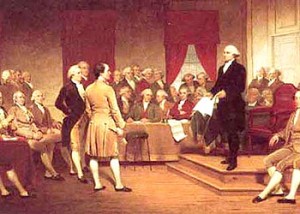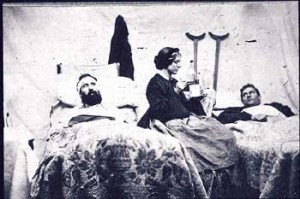 Over the summer, Voices blogger Margaret Haviland taught her first (mostly) online high school course — a survey of US History in six and a half weeks! Margaret journaled about her experience at her personal blog. I found it fascinating and imagined any teacher about to embark on a first-time online teaching experience would find Margaret’s narrative helpful.
Over the summer, Voices blogger Margaret Haviland taught her first (mostly) online high school course — a survey of US History in six and a half weeks! Margaret journaled about her experience at her personal blog. I found it fascinating and imagined any teacher about to embark on a first-time online teaching experience would find Margaret’s narrative helpful.
With her permission, we’ve excerpted large portions of her on-the-fly reflections here. You can read all five posts in their entirety at Breaking Down Walls. Margaret is the Director of Teaching and Learning at Westtown School in West Chester, PA. – John Norton, editor for Voices from the Learning Revolution.
6/20/12: The Great Experiment, Day 1!
Today was the first day of summer school. I am teaching US History, which I’ve been teaching off and on for 16 years. Nothing new there. The experiment is all in the delivery.
We are engaged in a blended online class. We have two days of face to face class time in a Westtown School classroom. After this we will meet for five additional weeks without ever being in the same room. One student will be traveling to China, another to Canada, a third to central PA, a fourth will be hiking in New England, and the others will be scattered through out the mid-Atlantic. A total of 10 students and me.
We will meet asynchronously and synchronously using a variety of online tools. Every Thursday we will meet using a web conferencing program called Adobe Connect. Between Thursdays, discussions will happen in our forums, wikis will be constructed, assignments uploaded and quizzes taken, all within Moodle.
When I thought about the organization of this class I was stymied by the challenge of covering the full sweep of US History — from pre-conquest Native Americans through to the election of Barack Obama — in just six weeks. Every online US History course I examined seemed to take this approach and rely heavily on weekly assignments and pacing that resembled a complete nine-month school year course.
A course structure based on student outcomes
Fortunately, a wise and forward thinking colleague reminded me to start with the outcomes I wanted and that with a new medium I needed a very different course structure. In his opinion, the problem with online high school classes is they try to replicate a face to face curriculum in a virtual space.
 My outcomes for my students include garnering a sense of the sweep and power of US History, to write well and to be able to think creatively about US History, and to make connections between the past and the present (I suspect we will skip over President Garfield yet again). I want them to know US geography and the inter-relationship between history and environment. Finally, I want them to see themselves as the next generation in a long line of people actively engaged in making history, involved in the civic life of their country and responsible for their future.
My outcomes for my students include garnering a sense of the sweep and power of US History, to write well and to be able to think creatively about US History, and to make connections between the past and the present (I suspect we will skip over President Garfield yet again). I want them to know US geography and the inter-relationship between history and environment. Finally, I want them to see themselves as the next generation in a long line of people actively engaged in making history, involved in the civic life of their country and responsible for their future.
We will do a lot of writing — two 5-7 page essays with proper bibliographic citation — as well as significant and regular writing in our discussion forum and their own current event blogs. The forum will be centered around questions of analysis, synthesis and creative thinking. Our wikis will be more fact based; geared toward building a foundation in the scaffold of events, issues, and people. There will be a collaborative project of their choosing. The final project will ask them to track a current event issue over the five weeks and write about it in a weekly blog. As they learn more about their topic, they are to engage with others beyond the confines of our class.
Our first day face-to-face
The first day went as I expected. It took us a significant amount of time to download the exact media driver for our school’s video streaming program, Safari Montage. Each different student-owned computer has its own particular hurdles and driver needs. Once we had everyone’s computer ready to stream videos, I showed them how to search the movie database and then I explained that while we would have a text book as a reference, they were free to read or watch videos to learn about any topic we were covering. One or two History Channel buffs were thrilled!
We then reviewed a number of online subscription services available to them as another alternative to the textbook. Tomorrow I will review with them how to select the best sites for learning and show them how to use the textbook most effectively.
We spent the last hour drawing freehand maps of North America. Students were to locate major rivers, oceans, lakes, mountain ranges and other geographical features. They also had to locate some major cities and correctly draw in the boundaries for all of Canada’s provinces. We will add the US states over the next few weeks. I was interested to watch their various strategies for locating things to be placed on the map. Some turned quickly to the textbook, others found maps online, and still others googled terms like Hudson River.
Tomorrow, we tackle the US Constitution and how to use Adobe Connect.
6/22/12: Day Two
All the kids came back! Well to be fair, their parents had paid tuition and they all had their own reasons for being present. We spent less time going over technologies and more time on content. We even had our first discussion. My one student who was connecting at a distance (from Missouri) had some internet problems at his end but I will follow up with him today on the phone.
 We spent most of the morning considering the lead up to writing the US Constitution. A short video reviewing the issues in the years following the American Revolution led into an examination of the three main plans brought to the Pennsylvania Convention. In small groups students compared the features of the plan and then began to examine the Constitution. The students quickly realized that this work — their first assignment — was going to be bigger than they could complete before we went our separate ways at noon.
We spent most of the morning considering the lead up to writing the US Constitution. A short video reviewing the issues in the years following the American Revolution led into an examination of the three main plans brought to the Pennsylvania Convention. In small groups students compared the features of the plan and then began to examine the Constitution. The students quickly realized that this work — their first assignment — was going to be bigger than they could complete before we went our separate ways at noon.
I helped the groups discuss strategies for working together. While not every student knew about Google Docs, by the end of class every group agreed to use it to complete their work. Beyond that two groups set up cell phone dates — two others (including the boy without his phone) agreed to use Facebook’s chat feature. Nothing earth-shattering here except that for five of the students, using Facebook for school was a new concept!
Valuable face to face assessment
So why start with the Constitution when the focus this first week is the time from the French and Indian War through to the War of 1812? The Constitution creates an important pivot in history. Students can follow threads from it back in time and make connections forward. The documents surrounding it, Madison’s notes, the Federalist Papers, writings from the Federalist and Anti-Federalist are challenging.
I wanted to be physically present to work with students and assess their ability to handle some of the most challenging documents we will approach together. Now I have a sense of my students’ strengths, weaknesses and strategies for handling challenge. I know who is going to fly — just need encouragement and directional pushes from me — who is going to need a fairly supported and scaffolded approach — and who is somewhere in between.
Before we broke up for the day we discussed the challenges they felt they would face going forward. I asked them to be very aware this week as they work through the readings, forum and wiki to consider their own learning style and what they will need to be able to create meaning for themselves, for this first 50 years we are covering.
Our next collected meeting will be in Adobe Connect next Thursday. Until then they meet asynchronously. I will be checking in via SKYPE with each of them before then.
6/30/12: ARRGH and success!
Last week was our first week of online learning in our US History class.
Here is what I have learned. . .
First: I gave way too much work, for the kids to do (they did finish) and for me to grade (I am still reading blog entries).
Second: You need to know your technology cold (unless you have helpful and understanding students!).
 Our first 30 minutes of virtual class were plagued by audio problems: echoes, dropped lines, and people talking too quietly. I had planned a break after the first 40 minutes. After the first trying 30 minutes, I suggested a short break, and I moved to a different location in my home — carpeted floors, wing back chair, no feedback! I turned off everyone’s speaker rights, opting for the one-speaker-at-a-time format.
Our first 30 minutes of virtual class were plagued by audio problems: echoes, dropped lines, and people talking too quietly. I had planned a break after the first 40 minutes. After the first trying 30 minutes, I suggested a short break, and I moved to a different location in my home — carpeted floors, wing back chair, no feedback! I turned off everyone’s speaker rights, opting for the one-speaker-at-a-time format.
It took a bit for the students to realize that when the mike icon appeared next to their name on the screen, they had the “floor” so to speak. I had to remember to toggle between each of them and myself until I figured out that I could “be on” even as I toggled between each of them. And I made sure everyone participated.
The last 45 minutes were much improved, with a solid discussion of the importance of slavery to all parts of the British Empire’s economic wealth, the point of no return in the lead up the American Revolution, and finally the crucial precedents set by the first three Presidents and the challenges they faced. Can you guess what they felt was George Washington’s greatest action (hint he did it twice!)?
The slides I had prepared kept us focused, but when I shared a web page, two students lost audio. I decided not to even try the YouTube video I had cued up. But I did use the chat to have students suggest ideas and post questions. I can see why, in managing the chat, an assistant would be a huge help!
(You must block private chats with high school students!!!)
Third: The discussion forum has rocked! Students wrote substantive analysis on Native Americans and why the French tended to co-operate with Native Americans while the British tended to opt for pushing them west, away from white settlement. On the topic of women and Republican Motherhood, students were intrigued with this “bone” to women and quickly began to discuss its flaws. [Read more about the students’ discussion here.]
I am still grading ( but the quality is excellent)…
No one is behind (except for maybe me)…
Students are fully engaged…
Next week, I will be a better manager of Adobe Connect.
7/12/12: The 3rd Week – Interest based learning
Ten students and one teacher:
- One is dealing with connectivity issues in Central Pennsylvania
- One is just returning from ten days of being off the grid in Mexico and poor hotel wi-fi in Toronto
- One spent six days at wrestling camp–no time after three a days and three showers a day.
- One is in China and finding the Great Wall applies to the internet as well. After five days of silence he finally reappeared to write an eloquent comparison of a speech by abolitionist Angelina Grimke and an essay by slavery apologist George Fitzhugh.
- One student is in Italy
- Six other students are chugging along — juggling work, friends, US History and managing to have some fun as well.
- I am behind in my grading.
- I SKYPED with three students since last Thursday and had email exchanges with the rest.
- By design I was less active in the Discussion Forum. The kids carried on beautifully.
How do you manage time zones? Our class meets in the evenings from 7-8:30 EST. In Italy that is 1-2:30 AM and China 7-8:30 AM.
 Tonight we shared projects! Every live online meeting adds some new experience and some new snag. The new feature was figuring out how to share videos with the kids. When I tried this the first week they could see but not hear. Tonight I had a solution and we had two student-produced videos.
Tonight we shared projects! Every live online meeting adds some new experience and some new snag. The new feature was figuring out how to share videos with the kids. When I tried this the first week they could see but not hear. Tonight I had a solution and we had two student-produced videos.
The first two students shared a video they had created about women’s participation in the Civil War. One student said, “I had no idea women dressed as men to enter the army, I thought they were just nurses.” This led into a discussion of wartime nursing and Florence Nightingale and his “just nurses” comment withered. Discussion shifted to disease in the camps, medical practices and what made this a modern war. Another student researched the role of drummer boys and created a film demonstrating some of the drum signals.
And now the snag: I had a great deal of lag caused by my audio. It got so bad, my computer froze and I decided to exit the program and reenter with IE instead of Chrome. Tonight I learned that the class continues even if I exit the program! While I was out, a student shared a poetry slam on the Ghost Dance and Wounded Knee. Other than the fact that my name disappeared they didn’t really notice and judging by the chat when I re-entered they had a lot to say about this poem.
We finished with a short discussion by me on the overall strategy of the Union and Confederate armies in the Civil War and Lincoln’s generals.
I asked one student to stick around after the other’s left to discuss with him the need to be more active in the chat. I was worried he had left on his computer and walked away. He talked with me about some of what was discussed and I was reassured he really had been present.
Overall a good class!
8/18/12: Reflections on this online learning experiment
First, would I teach US History in this online format again? YES
Second, did this consume too much of the time I would have otherwise spent reading for pleasure or sitting on my mother’s dock starring off at the lake? YES
So why, given how much I value summer for the time to read, would I do this again?
The paradox in the above statement is emblematic of so much about teaching 10 students US History in an online course. There are real trade offs that have to be made.
Face to face versus virtual: I believe absolutely in the teacher student relationship that happens within a bricks and mortar classroom, and the peer relationships that develop around those classroom tables. The online experiences is different. You have to work with great intentionality to make it personal, to make it human.
It helped that we began with two days in a real classroom. Assignments were created in such a way as to “force” conversations between peers in the discussion forum and the class wiki. And early projects were designed to be collaborations. Regular SKYPE check ins between myself and the students, even for just a five minute discussion of an assignment idea, were a necessity.
But the upside of this approach to building class cohesion and student support is that the learning is individualized. Rather than spending time preparing for four classes a week, I prepared for one class and focused on individual student thinking and learning the rest of the time.
 Time is precious: Time is an all too precious commodity in a 6.5 week summer school course. Over a 9-month school year, teachers feel pressed to cover all the content. Six and a half weeks raises that pressure at least five fold. I had to stay focused on the themes I wanted my students to have ingrained in their brains. Over these themes, stood my own working assumption about history–that history is created by the actions of ordinary (and sometimes extraordinary people).
Time is precious: Time is an all too precious commodity in a 6.5 week summer school course. Over a 9-month school year, teachers feel pressed to cover all the content. Six and a half weeks raises that pressure at least five fold. I had to stay focused on the themes I wanted my students to have ingrained in their brains. Over these themes, stood my own working assumption about history–that history is created by the actions of ordinary (and sometimes extraordinary people).
Within these themes, I had to let go of insisting every student learn every detail of (historical events). Did I make the right choices for my students? Should we have spent more time on Reconstruction or the Taft Presidency and how it compares to Roosevelt’s or Wilson’s (something I do when I teach US History over the course of the school year)?
I have colleagues who believe this is the only chance many of our students will ever have to learn the details of our history. In 6.5 weeks, either the details come fast and furious — in a blur– or the focus is on the big picture with details helping to ground those themes in time and place.
Students still need to communicate: Our live Thursday evening class time was a rich experience (even when the technology wasn’t perfect). The short class time worked because students had already been “talking” in the forum. The discussion forum worked because the students came to trust each other to read carefully and respond honestly — even when they didn’t agree.
There is a place for this sort of learning within the continuum of bricks and mortar all the way to large scale MOOCs. Done well, students learn both content and skills — skills they will encounter in their life, in a connected, high tech world.
This sort of learning helps to break down that artificial wall between what you learn at school and the rest of your life. The students learned at a time they were ready to learn — and in a manner that served their very different learning needs. Worthy outcomes.
Margaret Haviland
Latest posts by Margaret Haviland (see all)
- Student Creativity: the Importance of License and Limits - April 24, 2013
- Our US History Student Film Festival - January 31, 2013
- How I Spent My Summer Vacation — Teaching US History in Six Weeks to 10 Students Around the World - October 2, 2012


Pains, sorrow, anguish and so on. Because of the money the driver want to make, he decided not to let anyone know he was not fit for the trip.
Oftentimes, men tend to be notorious under-packers on vacation, while women tend to over-pack (“No, honey. We cannot bring an extra suitcase just for your 12 pairs of shoes” sound familiar?) Few people have found the perfect balance– the elusive and difficult to accomplish “just right” packed suitcase. It’s not unobtainable, though. It just takes a little bit of time and planning. Here’s what you need and how to pack for your vacation.Clothing essentials: what to packThere are some basic clothing essentials that you should bring on any summer vacation trip. One good thing to keep in mind while packing is that no one ever gets criticized for being the best dressed person in the room. –
Latest piece of writing straight from our personal blog
<http://www.healthmedicinelab.com/swimmers-ear-home-remedy/